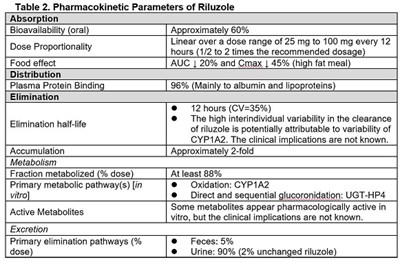Product Images Riluzole
View Photos of Packaging, Labels & Appearance
Product Label Images
The following 6 images provide visual information about the product associated with Riluzole NDC 42291-775 by Avkare, such as packaging, labeling, and the appearance of the drug itself. This resource could be helpful for medical professionals, pharmacists, and patients seeking to verify medication information and ensure they have the correct product.
figure2 - spl image 3 figure 2

This is a statistical report showing the Kaplan-Meler Survival Curves for a placebo group (N=242) and a group taking Riluzole 50 mg twice daily (N=236). The figure shows the survival probability over time. The other numbers (2 15 18 2) do not provide enough context to determine their meaning.*
table1 - table1

This is a comparison of adverse effects experienced by patients taking Riluzole Tablets 50 mg twice daily versus those taking a placebo. The study included 320 participants who took the placebo and 313 who took Riluzole. The table lists the percentage of patients experiencing different symptoms, such as asthenia, nausea, decreased lung function, hypertension, abdominal pain, dizziness, dry mouth, insomnia, pruritus, tachycardia, flatulence, increased cough, peripheral edema, urinary tract infection, circumoral paresthesia, somnolence, vertigo, and eczema.*
table2 - table2

Table 2 displays pharmacokinetic parameters of Riluzole. The oral bioavailability is approximately 60%, and it shows linearity in a dose range of 25 mg to 100 mg every 12 hours. The food effect shows an AUC of 20% and Cmax of 45% (high fat meal). Plasma Protein Binding is 96% and mainly to albumin and lipoproteins. Elimination half-life is about 12 hours, which has high interindividual variability potentially accountable to variability of CYP1A2. The primary metabolic pathway is through oxidation of CYP1A2 and glucuronidation through UGT-HP4. Approximately 80% is eliminated through urine, and at least 88% is fraction metabolized. Finally, some metabolites may be pharmacologically active even though the clinical implications are not known.*
* The product label images have been analyzed using a combination of traditional computing and machine learning techniques. It should be noted that the descriptions provided may not be entirely accurate as they are experimental in nature. Use the information in this page at your own discretion and risk.


